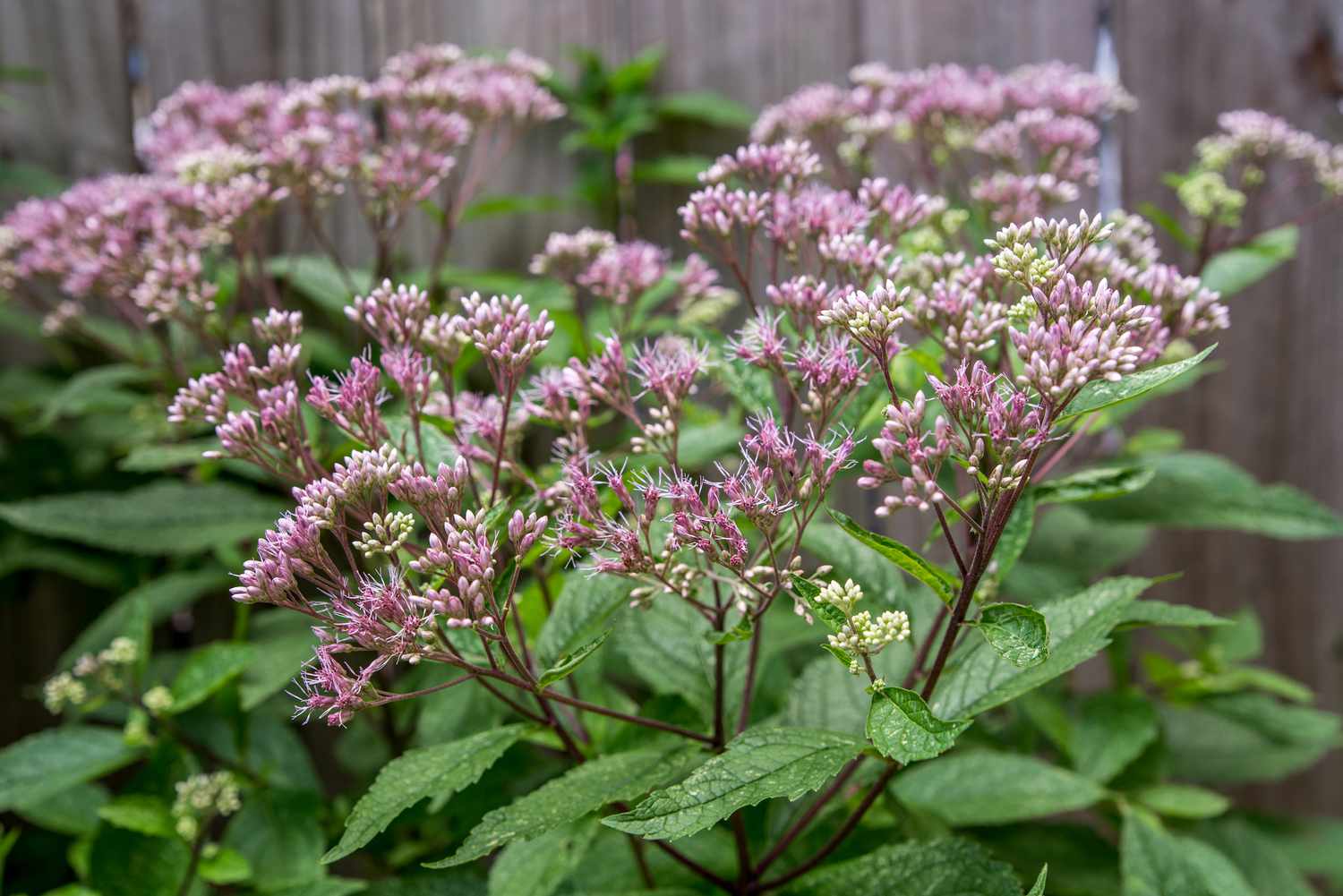
Joe Pye Weed, also known as Eupatorium purpureum, is a stunning perennial plant that is highly regarded among garden enthusiasts and nature lovers alike. With its tall, erect stems adorned with beautiful pinkish-purple flowers, Joe Pye Weed has become a staple in many gardens and landscapes.
But there’s so much more to Joe Pye Weed than meets the eye. In this article, we’ll uncover 16 astounding facts about this remarkable plant that will deepen your appreciation for its beauty and unique characteristics. From its intriguing cultural and historical significance to its medicinal properties and environmental benefits, Joe Pye Weed has truly earned its place as a beloved plant species.
Key Takeaways:
- Joe Pye Weed, a tall and vibrant plant, attracts pollinators and adds color to gardens in late summer. Its medicinal history and low maintenance make it a must-have for nature lovers and gardeners.
- With its ability to thrive in various soil conditions and attract beautiful butterflies, Joe Pye Weed is a versatile and visually striking addition to any garden or landscape. Its cultural significance and ecological benefits make it a plant worth celebrating.
The Origins of Joe Pye Weed
Joe Pye Weed, scientifically known as Eutrochium purpureum, is a perennial herbaceous plant that is native to eastern North America. It is named after a Native American healer named Joe Pye, who is believed to have used the plant for medicinal purposes.
A Favorite Among Pollinators
Joe Pye Weed is highly attractive to a wide variety of pollinators, including bees, butterflies, and hummingbirds. Its vibrant pink or purple flowers serve as important sources of nectar for these beneficial insects and birds.
Size Does Matter
Joe Pye Weed can grow to an impressive height of 4-7 feet, making it a standout plant in any landscape. Its tall, sturdy stems are adorned with whorls of lance-shaped leaves that provide an attractive backdrop for its flowers.
A Late Bloomer
The flowering period of Joe Pye Weed usually occurs in late summer or early fall, adding a burst of color to gardens and natural areas when many other plants have finished blooming.
Medicinal Uses
Joe Pye Weed has a long history of medicinal use. Native American tribes used various parts of the plant to treat ailments such as kidney stones, urinary tract infections, and fever. It was also believed to have anti-inflammatory properties.
Adaptable to Different Soil Types
Joe Pye Weed is known for its versatility and can thrive in a wide range of soil conditions. It can tolerate both wet and dry soil, making it a great option for gardens with varying moisture levels.
Beneficial for Ecosystems
Due to its attractive flowers and ability to attract pollinators, Joe Pye Weed plays an important role in supporting local ecosystems. It provides a valuable food source for many insects and helps to maintain biodiversity.
Low Maintenance
Once established, Joe Pye Weed requires minimal maintenance. It is a hardy plant that can withstand various weather conditions, making it an ideal choice for gardeners looking for low-maintenance plants.
Grows in Clumps
Joe Pye Weed tends to grow in clumps, forming dense patches of vegetation. This growth habit creates a visually striking display, especially when multiple plants are grouped together.
Winter Interest
Even during the winter months, Joe Pye Weed retains its structural appeal. The dried flower heads and seed pods add texture and interest to the garden, providing visual appeal when other plants are dormant.
Attracts Beautiful Butterflies
One of the greatest attractions of Joe Pye Weed is its ability to attract a wide variety of butterflies. Species such as Monarchs and Swallowtails are commonly seen fluttering around the vibrant blooms, creating a mesmerizing spectacle.
Propagation Methods
Joe Pye Weed can be propagated through both seeds and division. Collecting seeds from dried flower heads and dividing mature plants are effective methods to expand your Joe Pye Weed population.
Native Cultural Significance
Joe Pye Weed holds cultural significance for many Native American tribes. It is often used in traditional ceremonies and believed to have spiritual properties, further highlighting its importance in Indigenous cultures.
Drought-Tolerant Once Established
Although Joe Pye Weed prefers moist soil, it is surprisingly drought-tolerant once it has had time to establish its roots. This makes it a suitable choice for gardens in regions with limited water availability.
Adds Vertical Interest
Due to its impressive height, Joe Pye Weed adds vertical interest to gardens and landscapes. It can be strategically placed as a backdrop to shorter plants or as a focal point in larger garden beds.
Ecological Restoration
Joe Pye Weed is often used in ecological restoration efforts due to its ability to stabilize soil and attract pollinators. It has been successfully incorporated into wetland restoration projects and meadow restorations.
These 16 astounding facts about Joe Pye Weed highlight the beauty, versatility, and ecological importance of this remarkable plant. Whether you’re a gardener, nature enthusiast, or simply intrigued by the wonders of the natural world, Joe Pye Weed is a plant that deserves admiration and appreciation.
Conclusion
In conclusion, Joe Pye Weed is an incredible plant that deserves recognition for its many astounding qualities. From its beautiful appearance to its numerous medicinal benefits, this plant is truly remarkable. Whether you’re a gardening enthusiast, a nature lover, or simply curious about plants, exploring and learning more about Joe Pye Weed can be an enriching experience. So next time you come across this fascinating plant, take a moment to appreciate its unique features and the role it plays in our ecosystem.
FAQs
1. What is Joe Pye Weed?
Joe Pye Weed, also known as Eutrochium purpureum, is a perennial plant native to eastern North America. It is characterized by its tall stalks, clusters of pink or purple flowers, and lance-shaped leaves.
2. What are the growing conditions for Joe Pye Weed?
Joe Pye Weed thrives in moist to wet soil conditions and prefers full sun to partial shade. It can adapt to a wide range of soil types, including clay and sandy soils.
3. How tall does Joe Pye Weed grow?
On average, Joe Pye Weed can reach a height of 4 to 7 feet, making it an excellent choice for adding vertical interest to your garden or landscape.
4. Does Joe Pye Weed require any special care or maintenance?
Joe Pye Weed is relatively low-maintenance. It benefits from regular watering, especially during dry periods, but is generally resilient and hardy. Deadheading spent blooms can promote continuous flowering.
5. Are there any health benefits associated with Joe Pye Weed?
Yes, Joe Pye Weed has a long history of medicinal use by Native American tribes. It is believed to have anti-inflammatory, diuretic, and analgesic properties, and can be used to treat ailments such as urinary tract infections and kidney stones.
6. Can I attract pollinators to my garden with Joe Pye Weed?
Absolutely! Joe Pye Weed is a magnet for butterflies, bees, and other beneficial insects. By planting this species, you can create a vibrant and pollinator-friendly garden ecosystem.
7. Can Joe Pye Weed be grown in containers?
While Joe Pye Weed is typically grown in garden beds or borders, it can be grown in large containers as well. Ensure that the container is deep enough to accommodate the plant’s root system and provide adequate moisture.
8. Is Joe Pye Weed invasive?
No, Joe Pye Weed is not considered invasive. It spreads slowly and can be easily managed in a well-maintained garden or landscape.
9. When does Joe Pye Weed bloom?
Joe Pye Weed typically blooms from mid to late summer, adding a splash of color to your outdoor space when many other plants have finished flowering.
10. Can I divide and propagate Joe Pye Weed?
Yes, Joe Pye Weed can be divided in early spring or fall to propagate new plants. This is a great way to expand your garden or share this wonderful plant with others.
Joe Pye Weed's allure doesn't stop with just 16 facts. Dive deeper into this plant's captivating qualities, exploring additional tidbits about its growth habits and ecological importance. For those eager to expand their knowledge, consider investigating the plant's fascinating history and cultural significance among Native American tribes. Eupatorium, Joe Pye Weed's genus, also holds a treasure trove of intriguing facts waiting to be uncovered by curious minds.
Was this page helpful?
Our commitment to delivering trustworthy and engaging content is at the heart of what we do. Each fact on our site is contributed by real users like you, bringing a wealth of diverse insights and information. To ensure the highest standards of accuracy and reliability, our dedicated editors meticulously review each submission. This process guarantees that the facts we share are not only fascinating but also credible. Trust in our commitment to quality and authenticity as you explore and learn with us.


